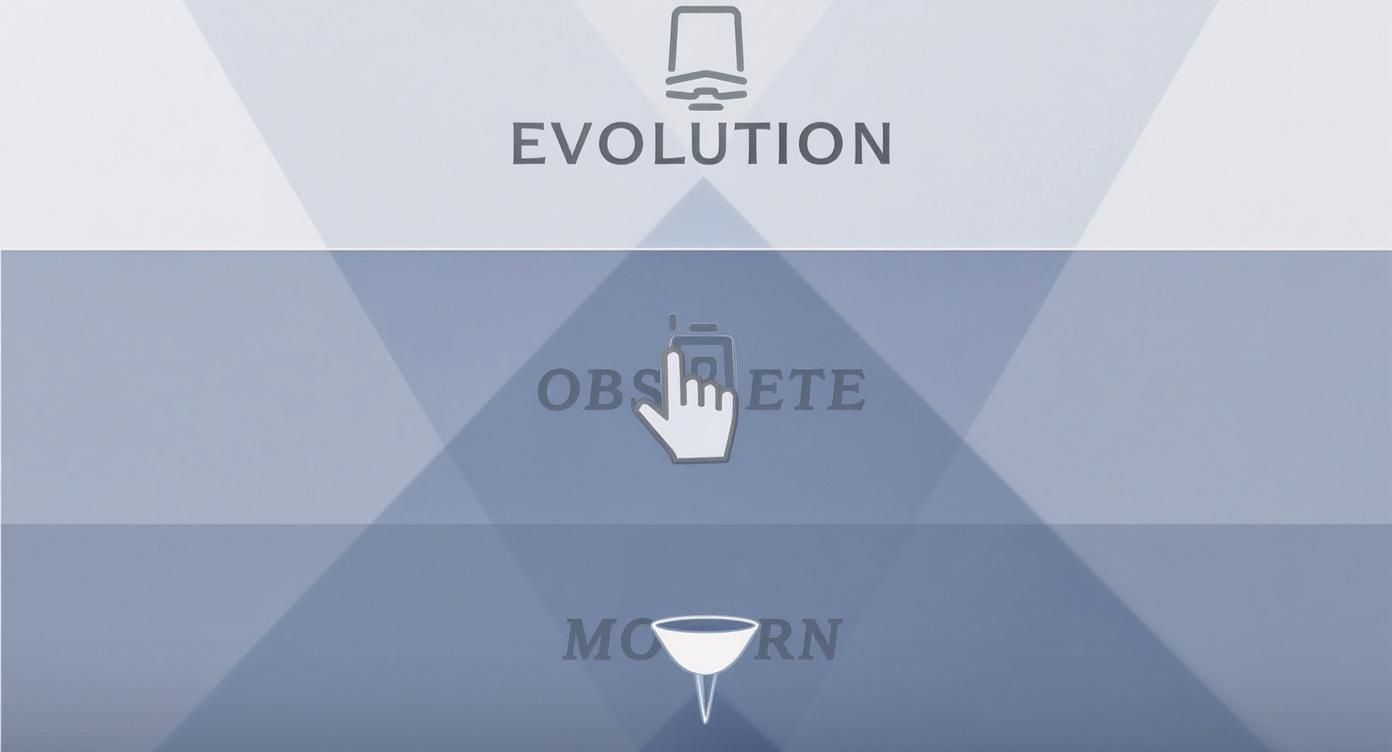Summary
Meta Description: Discover what marketing attribution is and why it's crucial for your business. Explore common models to measure ROI and make smarter, data-driven marketing decisions.
So, what exactly is marketing attribution?
Think of it as the science of figuring out which of your marketing efforts—that blog post, the Facebook ad, the email you sent last Tuesday—actually convinced a customer to buy something. It's how you give credit where credit is due. In short, marketing attribution helps you finally understand what’s working.
Are you ready to stop guessing and start knowing?
From Guesswork to Data-Driven Decisions
Ever stare at your marketing budget and wonder where the money really went? Without a solid attribution system, you’re basically just guessing which channels are pulling their weight. That’s the exact problem marketing attribution was created to solve.
Imagine your marketing strategy is a soccer team. A conversion is the final goal, but it’s rarely a solo effort. The journey usually involves multiple players passing the ball and setting up the perfect shot.
How Different Channels Play Their Part
A customer might first see your brand from a social media ad (the opening play). A few days later, they read a blog post (a solid mid-field pass). Finally, they click a link in an email to make a purchase (the game-winning shot).
So, who gets the credit? The striker who scored, the midfielder who made the assist, or the defender who started the whole play?
Marketing attribution is the referee analyzing the entire sequence, assigning value to each of those touchpoints along the way. This lets you see the full picture of your customer's journey, not just the final click.
Before we dive deeper, it's helpful to recognize the common players on the field. Here’s a quick rundown of typical touchpoints and the roles they often play.
Common Marketing Touchpoints and Their Purpose
Understanding these roles helps you appreciate just how interconnected everything is. Attribution helps you connect the dots.
By figuring out which channels are your star players and which ones provide the crucial assists, you can make much smarter calls on where to invest your time and money. To go even further, check out our guide on how to measure marketing campaign success and see how it all ties together.
Key Takeaway: Marketing attribution shifts your focus from just tracking the final conversion to understanding the entire journey that led to it. It replaces gut feelings with clear, actionable data.
The Journey From Last Click to Full Funnel
So, how did we get here? How did we go from giving all the credit to a single click to dissecting a customer's entire journey? The story of marketing attribution mirrors the explosion of the internet itself. Back in the early days of digital marketing, things were simple because the customer's path was simple.
The “last-click” model was the undisputed champion. It handed 100% of the credit for a sale to the final touchpoint a customer interacted with. If someone clicked a Google Ad and bought something, that ad got all the glory. This worked just fine when you only had a few channels to worry about.
Why Last Click Is No Longer Enough
But as digital channels multiplied, that clean, straightforward approach quickly fell apart. Customers were now seeing your brand on social media, stumbling upon your blog posts, and getting your emails long before they ever made a purchase. The customer journey stopped being a straight line and turned into a tangled web of interactions.
This shift made single-touch attribution an unreliable narrator for your marketing story. It completely ignored the critical awareness and consideration stages that warmed a customer up for that final, converting click.
The evolution of marketing attribution is tied directly to the digital revolution. By the mid-2000s, multi-touch attribution (MTA) models started popping up to spread the credit more accurately across all the different interactions a customer had, finally reflecting the true complexity of modern digital behavior.
Smart brands realized they were essentially flying blind. They couldn't see which of their initial efforts—like that killer blog post or engaging social media campaign—were actually starting valuable conversations. As you dig into tracking these touchpoints, understanding the bigger picture of the customer journey funnel becomes absolutely essential for getting attribution right.
This backstory is exactly why having a detailed attribution strategy isn't just a "nice-to-have" anymore; it's a must for accurate measurement. It's also why understanding related tactics is so crucial. For instance, get a better handle on the ecosystem by checking out our guide that answers, "what is retargeting in digital marketing?".
Exploring Common Marketing Attribution Models
Think of attribution models as different ways of telling the story of a conversion. Each model assigns credit based on its own set of rules, and the right one for you depends on what part of that story you need to understand. Some are simple, shining a spotlight on a single moment, while others paint a broader picture of the entire customer journey.
Let's break down the most common types. Getting a handle on how each one works is the first step toward figuring out which model will give you the most honest look at what’s really driving your results.
This infographic neatly shows the shift away from simplistic, single-click models toward more sophisticated multi-touch approaches that analyze the whole funnel.

As you can see, the industry is moving toward models that respect the complex, winding path customers take before they decide to buy.
Single-Touch Attribution Models
These are the most basic models because they give 100% of the credit to just one touchpoint. They’re a breeze to set up but often tell a dangerously oversimplified story.
First-Touch Attribution: This one’s all about the beginning. It gives full credit to the very first interaction a customer had with your brand. It’s a solid choice if your main goal is filling the top of your funnel and building brand awareness. For instance, if a user discovers you through a blog post and then converts from an email a month later, the blog post gets all the glory.
Last-Touch Attribution: In complete contrast, this model gives all the credit to the final touchpoint right before the conversion. It’s the default setting in many analytics platforms for a reason—it’s great for pinpointing which channels are your best "closers." If a customer clicks a retargeting ad and then buys, that ad gets the win, no matter what came before.
Multi-Touch Attribution Models
This is where things get more interesting. Multi-touch models operate on the belief that it takes a village to raise a conversion. They spread the credit across several touchpoints, giving you a much more realistic and complete view of what’s working.
The real magic of multi-touch models is that they paint a more honest picture of performance. They stop you from making the classic mistake of cutting the budget for a channel that plays a vital "assist" role early in the game.
To help you get a clearer sense of the options, here’s a quick rundown of the most common models.
A Comparison of Marketing Attribution Models
Choosing the right model from this table comes down to what you value most in your customer's journey—the first hello, the final handshake, or all the conversations in between. Which one best fits your business goals?
The move toward these more nuanced models isn't just a trend; it's backed by solid data. Research consistently shows that between 70% to 90% of conversions happen after a customer has interacted with a brand multiple times. This fact alone highlights just how much you miss when you only look at a single touchpoint. If you want to dive deeper, you can discover more insights on multi-touch model effectiveness and see why they are so crucial for accurate measurement today.
So, What Do You Actually Get Out of Attribution?
Knowing the different models is great, but let's get down to brass tacks. What's the real-world payoff of putting a solid marketing attribution strategy in place? This is where we move from theory to impact, turning your marketing efforts into a smarter, more efficient machine. It’s all about making confident decisions backed by hard data.

Right off the bat, the biggest win is optimizing your marketing spend. Attribution finally pulls back the curtain on the true ROI of each channel. It lets you stop throwing money at campaigns that aren't pulling their weight and gives you the confidence to double down on what actually works.
This kind of clarity is gold for anyone trying to figure out how to reduce customer acquisition costs and stretch their budget further.
Beyond the budget, proper attribution gives you a much richer understanding of the entire customer journey. You get to see which touchpoints are the real MVPs—the ones crucial for nudging a prospect from "just browsing" to "take my money."
Boost Performance and Get Your Teams on the Same Page
Once you have these insights, you can start making some serious improvements. You'll fine-tune your campaign performance and create more personalized experiences that resonate with customers. For instance, if you know a particular blog series is a key first touch for new leads, you can confidently invest more in creating similar content.
Attribution becomes the universal translator between your marketing and sales teams. When everyone can see a clear, data-driven line from a marketing touchpoint to a closed deal, that old friction just melts away.
This shared perspective proves marketing’s direct impact on the bottom line, shifting the conversation from marketing as a cost center to a powerful revenue engine.
Here’s a quick rundown of what you gain:
- Smarter Budget Allocation: Funnel your cash into high-performing channels and axe the ones that don’t deliver a real return.
- Deeper Customer Insights: Uncover the hidden pathways and critical moments that genuinely influence your customers' buying decisions.
- Higher Campaign ROI: Dial in your messaging and channel strategy to lift conversion rates across the board.
- Sales and Marketing Harmony: Finally get both teams on the same page with a single source of truth for how leads are generated and nurtured.
Navigating Modern Attribution Challenges
While marketing attribution gives us a powerful lens into campaign performance, let's be honest—it’s not a perfect science. The ground beneath our feet is constantly shifting, throwing new and complex obstacles in our path. To keep our measurements accurate, we have to learn how to navigate this changing terrain.
For years, we all leaned heavily on cookies, pixels, and device IDs to piece together the customer journey. But a massive consumer privacy movement has completely changed the game. Thanks to new regulations and shifting expectations, what used to be standard practice is now a huge challenge.
The Impact of Privacy and Tech Shifts
The two biggest forces reshaping attribution are strict privacy laws and major updates from the tech giants. Think of regulations like GDPR in Europe or Apple’s App Tracking Transparency (ATT) framework. These moves put control back in the hands of consumers, but they also severely limit the data marketers can scoop up.
This is most obvious with the slow death of third-party cookies, which were the backbone of cross-site tracking for a long time. As browsers phase them out, our ability to follow a user from one website to another is basically vanishing. This is forcing us to pivot from tracking individuals toward more aggregated, privacy-friendly methods.
Key Insight: The future of attribution isn't about tracking every single click across the web. It's about getting smarter with the data you actually own and respecting user privacy, all while still finding those golden nuggets of insight.
How to Adapt and Stay Ahead
So, how do you keep your attribution clear in this new privacy-first world? The answer is to adapt your strategy and double down on the data you can reliably collect and control.
Here are a few ways to get started:
- Prioritize First-Party Data: Your best bet is to collect data directly from your audience. Think newsletter sign-ups, website forms, and customer accounts. This info is not only more accurate but it’s also given with consent, making it a rock-solid foundation for attribution.
- Unify Your Data Sources: Stop letting your data live in silos. Pull everything from your CRM, analytics tools, and ad platforms into one central place. A unified view helps you connect the dots without needing to rely on sketchy third-party tracking.
- Explore New Methodologies: It's time to look into privacy-safe approaches like Media Mix Modeling (MMM) to understand channel impact from a bird's-eye view. Getting a handle on tricky issues, like measuring a user's journey across multiple devices, is absolutely crucial. You can sharpen your skills by learning more about cross-device video tracking and analytics.
Your Marketing Attribution Questions Answered
Even when you’ve got a handle on the models and benefits, putting attribution into practice brings up a few real-world questions. Let's tackle some of the most common ones so you can move forward with confidence and sidestep the usual bumps in the road.
The good news? Getting started is probably simpler than you imagine. The secret is to start small, get to know your data, and build up from there—don't feel like you need to roll out a complex, multi-touch model on day one.
How Do I Get Started With Marketing Attribution?
First things first, make sure your analytics platform—like Google Analytics—has clear conversion goals set up. You can't track what you don't define.
Start with the default model, which is usually Last-Touch, to get a simple baseline. As the data flows in, spend time in your customer journey reports to see which paths people take most often. Once you're comfortable, you can start exploring the other models available right inside your tools. The goal is to grow into it, not to master it overnight.
What Is The Difference Between Attribution And Analytics?
Think of it like this: marketing analytics is the entire dashboard of your car. It shows you everything at once—your speed, your fuel level, your engine temperature. It's the big-picture view of your overall performance.
Marketing attribution, on the other hand, is the GPS. It’s a specialized tool within your dashboard focused on one single, critical job: telling you the exact route (your marketing channels) that led you to your destination (a conversion).
While analytics tells you what happened, attribution tells you why.
The core distinction is focus. Analytics gives you the wide-angle lens on performance, while attribution zooms in to assign credit for conversions to the specific touchpoints that made them happen.
Can Marketing Attribution Survive Without Cookies?
Absolutely, but the game is changing. The slow death of third-party cookies means the old-school way of connecting dots across different websites is fading out. The future of attribution relies on different, more privacy-friendly methods.
This means a much bigger emphasis on things like:
- First-party data: Information your customers give you directly. This is gold.
- Contextual advertising: Placing ads based on the content of a page, not a user's browsing history.
- Statistical approaches: Using high-level models like Media Mix Modeling (MMM) to spot broader trends instead of tracking individuals.
It’s really a shift from tracking individuals one-by-one to understanding the wider impact of your marketing. This makes the direct relationships you build with customers more valuable than ever before.
Ready to connect your ad spend directly to conversions with pinpoint accuracy? LanderMagic creates dynamic, high-converting landing pages that are perfectly tailored to every Google Ads click, giving you cleaner data for more effective attribution. Start optimizing your post-click experience and see your ROI climb by visiting https://landermagic.com.









